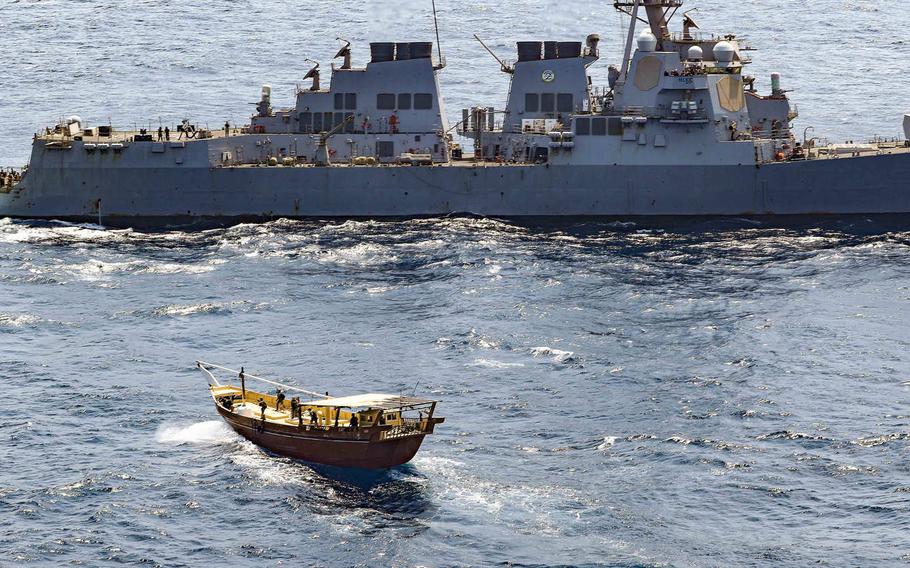US Navy still searching for 2 SEALs missing in the Gulf of Aden By ALISON BATH STARS AND STRIPES • January 14, 2024
- by John Currin

Service members from the destroyer USS Winston S. Churchill board a stateless dhow off the coast of Somalia on Feb. 12, 2021. (Louis Thompson Staats IV/U.S. Navy)
Two Navy SEALs still are missing in the Gulf of Aden more than two days after conducting nighttime operations off the coast of Somalia.
The incident happened Thursday as the SEALs were attempting to board a suspicious vessel in rough seas, The Associated Press reported Saturday, citing unnamed U.S. officials.
One SEAL was attempting to board the vessel when they were knocked off by high waves, AP reported. The other SEAL jumped into the sea to rescue their team member, according to the AP report.
Search and rescue efforts are ongoing in the Gulf of Aden, where the waters are warm, AP reported.
U.S. Central Command confirmed in a statement on Friday that the sailors were missing but did not offer additional details out of operational security concerns and respect for the families. The statement did not say what Navy ships or other U.S. military personnel may have been involved.
It wasn’t clear why the vessel drew the team’s attention. Naval forces in the U.S. 5th Fleet area of operations regularly conduct operations intercepting weapons being sent to Iranian-backed Houthi militants in Yemen.

Map shows the Kenya-Somalia coastline and disputed area. (AP)
In January 2023, Navy forces intercepted 2,116 AK-47 rifles from a vessel in the Gulf of Oman along a maritime route from Iran to Yemen, Stars and Stripes reported at the time.
That incident came after similar interdictions in late 2022 that resulted in the seizures of more than 170 tons of potentially explosive chemicals and 50 tons of ammunition rounds, fuses and rocket propellants from fishing vessels also transiting in the same area.
Those international interdiction efforts also intercept millions of dollars in heroin, methamphetamine, hashish and other illicit drugs. The latest of those operations resulting in the seizure of an estimated $11 million of illegal drugs from a vessel on Jan. 5 by a U.S. Coast Guard cutter operating under Combined Task Force 150 of the Combined Maritime Forces, U.S. 5th Fleet said in a statement on Jan. 8.
That interdiction followed others in late December that seized nearly $50 million in illegal drugs, the Navy said.
U.S. officials have said proceeds from drug sales are used to finance weapons for Houthi militants. Since Nov. 19, Houthi militants in Yemen have attempted to attack or harass ships in the Red Sea and Gulf of Aden 28 times, CENTCOM said Saturday in a post to its official page on the social media platform X, formerly known as Twitter.
Those attacks included the use of anti-ship ballistic missiles, unmanned aerial vehicles and cruise missiles, CENTCOM said.
The January 2023 seizure of the rifles “is part of a continued pattern of destabilizing activity from Iran,” Vice Adm. Brad Cooper, commander of U.S. Naval Forces Central Command/ U.S. 5th Fleet, said at the time.
U.S. officials were careful to distance interdiction efforts in the region and retaliatory strikes on Friday and Saturday against Houthi-controlled military sites in Yemen from Operation Prosperity Guardian, a multinational effort to address Houthi militant attacks on ships in the Red Sea.

from Blogger https://ift.tt/jafdGc3
via IFTTT
Share this:
- Click to share on Facebook (Opens in new window) Facebook
- Click to share on X (Opens in new window) X
- Click to share on Reddit (Opens in new window) Reddit
- Click to share on Tumblr (Opens in new window) Tumblr
- Click to share on Pinterest (Opens in new window) Pinterest
- Click to email a link to a friend (Opens in new window) Email
- Click to print (Opens in new window) Print

















